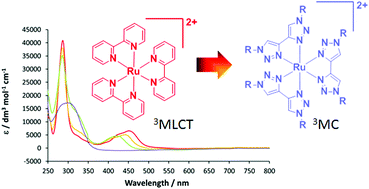Synthesis, characterisation and theoretical study of ruthenium 4,4′-bi-1,2,3-triazolyl complexes: fundamental switching of the nature of S1 and T1 states from MLCT to MC†
Abstract
The series of complexes [Ru(bpy)3−n(btz)n][PF6]2 (bpy = 2,2′-bipyridyl, btz = 1,1′-dibenzyl-4,4′-bi-1,2,3-triazolyl, 2n = 1, 3n = 2, 4n = 3) have been prepared and characterised, and the photophysical and electronic effects imparted by the btz ligand were investigated. Complexes 2 and 3 exhibit MLCT absorption bands at 425 and 446 nm respectively showing a progressive blue-shift in the absorption on increasing the btz ligand content when compared to [Ru(bpy)3][Cl]2 (1). Complex 4 exhibits a heavily blue-shifted absorption spectrum with respect to those of 1–3, indicating that the LUMO of the latter are bpy-centred with little or no btz contribution whereas that of 4 is necessarily btz-centred. DFT calculations on analogous complexes 1′–4′ (in which the benzyl substituents are replaced by methyl) show that the HOMO–LUMO gap increases by 0.3 eV from 1′–3′ through destabilisation of the LUMO with respect to the HOMO. The HOMO–LUMO gap of 4′ increases by 0.98 eV compared to that of 3′ due to significant destabilisation of the LUMO. Examination of TDDFT data show that the S1 states of 1′–3′ are 1MLCT in character whereas that of 4′ is 1MC. The optimisation of the T1 state of 4′ leads to the elongation of two mutually trans Ru–N bonds to yield [Ru(κ2-btz)(κ1-btz)2]2+, confirming the 3MC character. Thus, replacement of bpy by btz leads to a fundamental change in the ordering of excited states such that the nature of the lowest energy excited state changes from MLCT in nature to MC.


 Please wait while we load your content...
Please wait while we load your content...